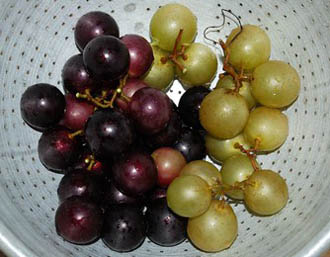Table of Contents
Selection and storage
Muscadines are typically in season from late August to early October in the United States, depending on the region and weather conditions.
While choosing, look for ripe muscadines which should be plump, firm, and fully colored. They should have a deep, rich color that is specific to the variety of muscadine. The stem should be green and supple. Avoid muscadines that are overly soft, mushy, or have blemishes. Also, avoid those with dried or brown stems, which can indicate that they are overripe.
At home, muscadines can be stored in a few different ways depending on how ripe they are and how soon you plan to use them. If the muscadines are not quite ripe yet, you can store them at room temperature in a dry, cool area away from direct sunlight. This will allow them to ripen slowly over the course of a few days.
Ripe muscadines and don’t plan to eat them right away, you can store them in the refrigerator to extend their shelf life. Put them in a plastic bag or container with a lid, and make sure they are dry before storing them.
Preparation and serving method
Muscadine grapes enjoyed fresh, as a snack or dessert. They are also commonly employed for making wine, juice, jelly, and other culinary products.
Here are some serving tips;
-
Add to a salad: Muscadines can be sliced and added to a salad for a burst of sweetness. They pair well with nuts, cheese, and vinaigrette dressings.
-
Make jelly or jam: Muscadines are naturally high in pectin, which makes them perfect for making jams and jellies. You can use the pulp of the fruit along with sugar and pectin to create a delicious spread for toast or biscuits.
-
Bake a pie: Muscadines make a great filling for pies. Simply mix the fruit with sugar, flour, and a little bit of cinnamon and bake in a pre-made pie crust.
-
Make a sauce: Muscadines can be cooked down into a sweet and tangy sauce that is perfect for drizzling over ice cream, pancakes, or waffles.
-
Make a cocktail: Muscadines can be muddled and added to cocktails for a fruity and flavorful twist. Try mixing with vodka, lemon juice, and simple syrup for a refreshing summer drink.
Safety profile
Muscadine grapes are generally considered safe to eat and are a healthy addition to a balanced diet. However, as with any food, there are some precautions to keep in mind:
-
Pesticides: Muscadine grapes, like many fruits and vegetables, may be treated with pesticides to protect them from insects and diseases. To reduce exposure to harmful chemicals, it’s best to choose organic or locally grown muscadines, or to thoroughly wash and rinse the grapes before eating them.
-
Allergies: Some people may be allergic to grapes, including muscadines. Symptoms of a grape allergy may include itching, hives, swelling, and difficulty breathing. If you experience any of these symptoms after eating muscadines or any other grape variety, seek medical attention immediately.
Also read on-
≻≻-Grapes Nutrition facts and Health benefits.
≻≻-Raisins Nutrition facts and Health benefits.
≻≻-Back to Fruits from Muscadines. Visit here for an impressive list of all varieties of fruits with complete illustrations of
their nutrition facts and health benefits.
≻≻-Back to Home page.
Further reading and Resources:
-
Refer Stanford School of MedicineCancer information Page- Nutrition to Reduce Cancer Risk. (Opens in new window).





More Stories
Avocado Cacao Mousse – JSHealth
Janelle Brown on Garrison’s Mental Health Before His Death
How To Finally Beat Insomnia